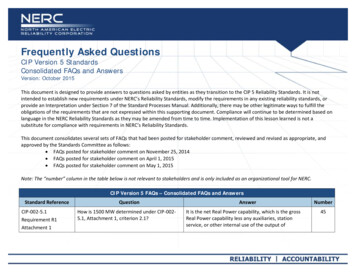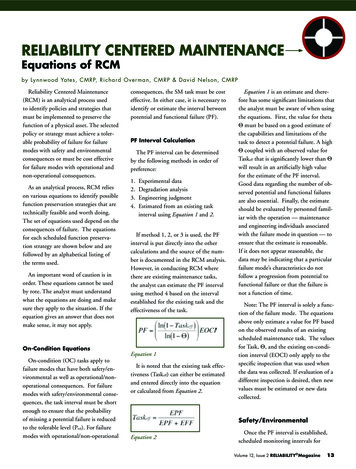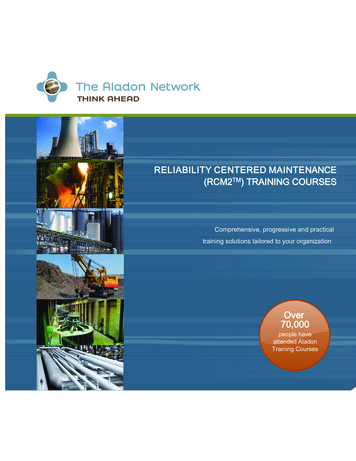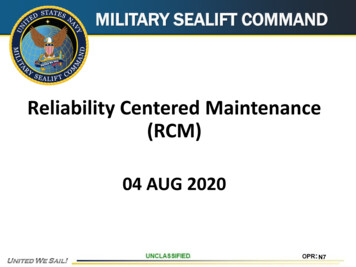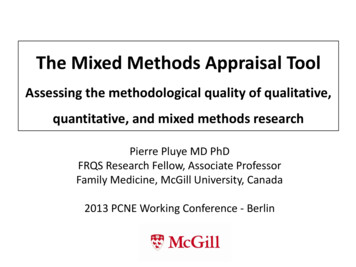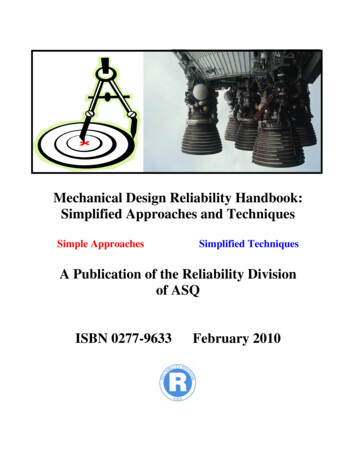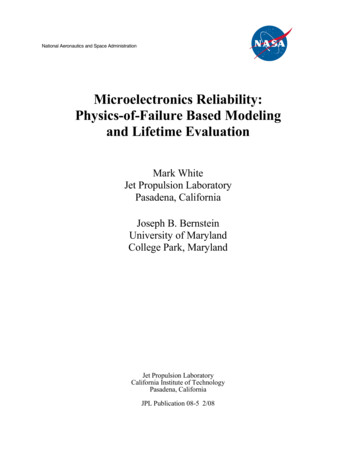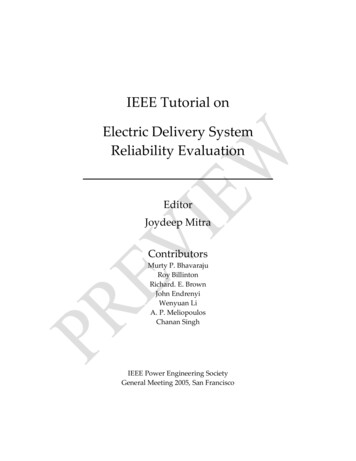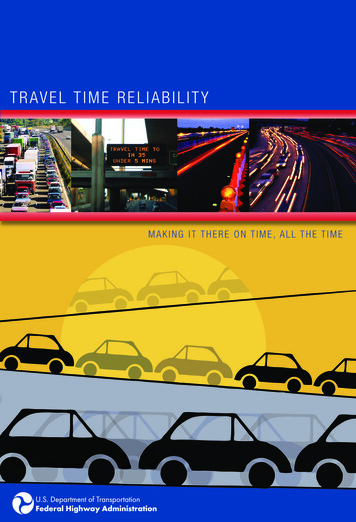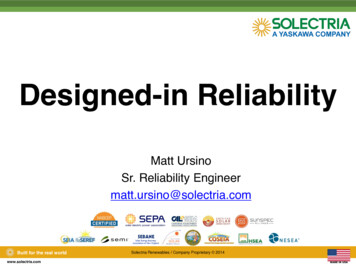
Transcription
Designed-in ReliabilityMatt UrsinoSr. Reliability Engineermatt.ursino@solectria.comBuilt for the real worldwww.solectria.comSolectria Renewables / Company Proprietary 2014
Built for the real worldwww.solectria.comSolectria Renewables / Company Proprietary 2014
Designed-in ReliabilityHow do we “design-in” reliability?1) Careful selection of components2) Derating components to increase design margins3) Stress Testing (HALT, ALT, HASS, etc.)Built for the real worldwww.solectria.comSolectria Renewables / Company Proprietary 2014
Careful component selection:Ceramic Capacitors - Flex cracksFlexible terminationBuilt for the real worldwww.solectria.comSolectria Renewables / Company Proprietary 2014
Film Capacitors vs. ElectrolyticIdentical cap bank composed of 600V capacitorsElectrolytic CapacitorsMTBF 2.7 million hrsUseful Life 10-15 yrsFilm CapacitorMTBF 2.6 million hrsUseful Life 20-30 yrsMTBF calculation via Telcordia StandardElectrolytic Caps have dry-out failures in 10-15 yearsBuilt for the real worldwww.solectria.comSolectria Renewables / Company Proprietary 2014
Derating of componentsBasically running a component well below their max ratings:For exampleOperating an 800V Film capacitor at 600VorFor exampleBuilt for the real worldwww.solectria.comOperating a resistor at 50% of it’s max rated powerSolectria Renewables / Company Proprietary 2014
Opto-couplersAmbient TempsUsed in many critical GFDI circuits as well as other voltage isolation circuits.25CMTBF 129 million hrs60CMTBF 5.38 million hrs(FIT 7.75)(FIT 186)That’s 24 times reduction in MTBF 60C vs. 25C!!!MTBF calculation via Telcordia StandardBuilt for the real worldwww.solectria.comSolectria Renewables / Company Proprietary 2014
Types of Stress testing:What is HALT (Highly Accelerated Life Testing)?HALT is a stress testing method used to determine the operating and destruct limitsof a design - why those limitations exist and what is required to increase thosemargins. HALT, therefore, stresses products beyond their design specifications andlooks for weak links in the design.What is ALT (Accelerated Life Testing)?ALT is the process of testing a product by subjecting it to conditions (temperatures,voltage, vibration rate, pressure etc.) in excess of its normal service parameters inan effort to uncover potential modes of early wear-out/failure in a relatively shortamount of time.Built for the real worldwww.solectria.comSolectria Renewables / Company Proprietary 2014
And what about HASS (Highly Accelerated Stress Screen)?HASS testing is an accelerated reliability screen that can be done in production andcan reveal latent flaws not detected by ESS, burn-in and other test methods. HASStesting uses stresses beyond specification, but within the capability of the design asdetermined by the HALT.Built for the real worldwww.solectria.comSolectria Renewables / Company Proprietary 2014
HASSBuilt for the real worldwww.solectria.comSolectria Renewables / Company Proprietary 2014
HALT Testing at SolectriaBuilt for the real worldwww.solectria.comSolectria Renewables / Company Proprietary 2014
Typical HALT set upSignal monitoring wiresThermocouplesBuilt for the real worldwww.solectria.comSolectria Renewables / Company Proprietary 2014
Cold and Heat being guided to critical circuits via air ductsBuilt for the real worldwww.solectria.comSolectria Renewables / Company Proprietary 2014
Phase 1 Built for the real worldwww.solectria.com10C steps, 15 minute dwells2minutes before end of dwell we induceda GFDI faultSolectria Renewables / Company Proprietary 2014
Example of finding during thermal step stressInsulatorfailureBuilt for the real worldwww.solectria.comSolectria Renewables / Company Proprietary 2014
Phase 2 Built for the real worldwww.solectria.com5 cycles, 20 minute cycles2minutes before end of cycle we induceda GFDI faultSolectria Renewables / Company Proprietary 2014
Example of findings during thermal cycle stressCurrent sensor still working butinaccurate after 4th cycleBuilt for the real worldwww.solectria.comSolectria Renewables / Company Proprietary 2014
Phase 3 0gRMS to 60gRMS in 5gRMS increments10 minutes dwellsStarting at 30gRMS, 9 minute dwells 1 minute at 5gRMS2 minutes before end of dwell we induced a GFDI faultBuilt for the real worldwww.solectria.comSolectria Renewables / Company Proprietary 2014
Examples of findings during vibration stressConnector popped outBuilt for the real worldwww.solectria.comSolectria Renewables / Company Proprietary 2014
Componentsheared off(need to add RTV)Built for the real worldwww.solectria.comSolectria Renewables / Company Proprietary 2014
Phase 4Built for the real worldwww.solectria.comSolectria Renewables / Company Proprietary 2014
Examples of findings during Combined stress testCracked highvoltage capacitorBuilt for the real worldwww.solectria.comSolectria Renewables / Company Proprietary 2014
Test ofruggedizedcomponentswith RTVBuilt for the real worldwww.solectria.comSolectria Renewables / Company Proprietary 2014
ALT at SolectriaIncrease ambienttemperatureBlock air intake toreduce air-flowBuilt for the real worldwww.solectria.comSolectria Renewables / Company Proprietary 2014
Solectria ALT (Accelerated Life Testing) set up:1) Limit air-cooling by blocking intake, power stages should be on the edge ofgoing into derating mode.2) Adjust intake air temp and blocking to achieve 70C cabinet temp and 80Cinside power stage enclosure (DMGI enclosure)3) Operate at maximum voltage and power level.4) Run continuous cycles with the following power levels. 100% power for 11 hrsand 5% power for 1 hr, this will thermal cycle the power stages and allcomponents inside the cabinetBuilt for the real worldwww.solectria.comSolectria Renewables / Company Proprietary 2014
Calculating Acceleration FactorComparative form of Arrhenius EquationMost component manufacturers recommend using an Activation Energy (Ea) between 0.7 and 1 eVBuilt for the real worldwww.solectria.comSolectria Renewables / Company Proprietary 2014
Acceleration Factor for Cabinet ComponentsThe “Typical/Average” cabinet temp in the field is 40CBlock air-flow to achieve a cabinet temp of 70CActivation Energy (Ea) 0.8eVEnter valuesT1 ( C)40Acceleration Factor Built for the real worldwww.solectria.comT1 ( C)70Ea (eV)0.813Solectria Renewables / Company Proprietary 2014T1 ( K)313.15T2 ( K)343.15Ae/k9283.971/T1 - 1/T2 2.79E-042.592
How long do we need to run ALT to equal 20 years?A typical inverter operates 14 hrs a day for 20 yearsTotal hrs 14hrs/day x 365 days x 20yrs 102,200 hrs102,200 hrs / Acceleration FactorAF 13102,200 hrs/13 7862 hrsSince we are running ALT for 11 hrs @100% power and 1 hr @5% power that’s 22hrs/day running at Full Power.7862 hrs 22 hrs/day 357 days or about 12 monthsBuilt for the real worldwww.solectria.comSolectria Renewables / Company Proprietary 2014
Questions?Built for the real worldwww.solectria.comSolectria Renewables / Company Proprietary 2014
HASS testing is an accelerated reliability screen that can be done in production and can reveal latent flaws not detected by ESS, burn-in and other test methods. HASS testing uses stresses beyond specification, but within the capability of the design as determined by the HALT.

